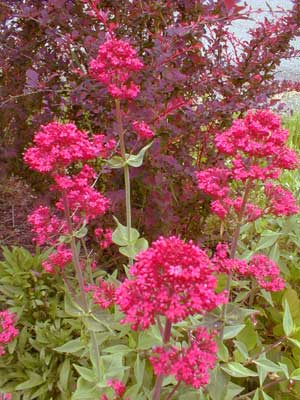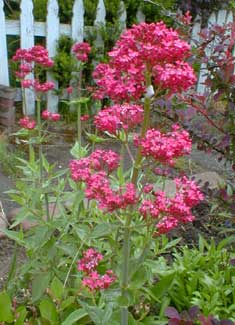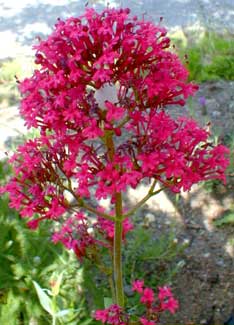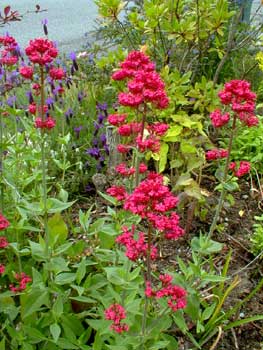
Red Valerian, aka:
Jupiter's Beard, Sweet Mary,
Pretty Betsy, Delicate Bess,
or Sweet Setywall
"Flowers I would bring
if flowers could make thee fairer."
-Aubrey Thomas De Vere
(1814-1902)
(1814-1902)
 Ages ago when I worked in the University of Washington Hospital, I would take a bag lunch with me to the Medicinal Garden, which by rights should be famous but was almost always completely devoid of any persons other than myself. In that garden is an old patch of Red Valerian (Centranthus ruber).
Ages ago when I worked in the University of Washington Hospital, I would take a bag lunch with me to the Medicinal Garden, which by rights should be famous but was almost always completely devoid of any persons other than myself. In that garden is an old patch of Red Valerian (Centranthus ruber).Granny Artemis & I planted a start of Red Valerian out on the street in 2002. This is a somewhat harsh xeriscape sun-garden, so the little plant took some while becoming a large clump, & was not substantial until 2005, plus a couple little seedlings nearby. Since then, as of 2009, there is red valerian popping up all over, it self-seeds so easily, though not so that I'd call it aggressive.
The specific cultivar that we have is 'Coccineus,' probably the reddest of the reds (there are also pink & white varieties). Supposedly 'Coccineus' is only about three feet tall but our young plant in its first year sprang up to a gawky four & a half feet, striving to get above the Japanese Barberry bush into full sunlight, bursting forth with brilliant rich red flowers amidst the purple barberry leaves.
In 2009 I finally removed the barberries in favor of a more extensive perennial garden, but it's nice to have for memory's sake a few portraits of Red Valerian against Red Barberry. So for that year the Red Valerian didn't stretch itself quite so tall as it had plenty of sun top to bottom.
Its first year, it was in full bloom in July 2002. In early August of its first year I removed the fluffy seeds before the wind could carry them to parts unknown & I buried them around the foot of the lanky tall start, & trimmed it to a more normal height. In September & in October, it rebloomed in even greater glory. Deadheading encourages rebloom & in warmer areas it can be encouraged to keep blooming until November. In some years that followed, however, I neglected to deadhead, & once it has expended a lot of energy producing fluffy seeds, it doesn't rebloom as powerfully or as long.
 The following year it began blooming sooner. It was in full bloom by early June. As the clump aged & toughened, it would not be unusual for it to bloom starting late April or in May, & from 2004 up to today, it is most powerfully abloom in May.
The following year it began blooming sooner. It was in full bloom by early June. As the clump aged & toughened, it would not be unusual for it to bloom starting late April or in May, & from 2004 up to today, it is most powerfully abloom in May.In 2004, a seedlings from the year before sprang up to four feet tall & bloomed ahead of the main patch, in May; its flower is shown in the third photo. In 2005 it was tepidly abloom in April & in full sway by May (shown in the second photo). So now the old clump seems truly everblooming from late April to October or later, if assisted by deadheading through the year whenever it seems to be about to stop.
The other type of Valerian commonly sold medicinally is Valeriana officinalis, the root of which is a potent tranquilizer & an old midwife drug for inducing abortion. Red Valerian is not so potent (nor as risky), so is not as well-famed for medicinal properties.
 Several websites repeat almost word for word that Red Valerian has no medicinal value, & perhaps it doesn't since many plants used medicinally are indeed worthless for the sundry things allegedly to be cured. Nevertheless, & most assuredly, Red Valerian has been used as a folk remedy in southern Europe from time immemorial.
Several websites repeat almost word for word that Red Valerian has no medicinal value, & perhaps it doesn't since many plants used medicinally are indeed worthless for the sundry things allegedly to be cured. Nevertheless, & most assuredly, Red Valerian has been used as a folk remedy in southern Europe from time immemorial.The flowers, young shoots, roots, & soft young leaves are a folk remedy for cold, flu, or cough, even though almost certainly ineffective. As an edible plant only the young leaves are soft enough to be pallatable raw for salads, but more of the leaves can be useful dried & broken to bits to add to soups. Red Valerian roots, which for an old clump can be deep & thick & large, are also used in soups.
Red Valerian is native of the Mediterranean region, ie., Portugal, Italy, northern Africa, into Asia minor. It self-seeds rather too reliably & can in some places be invasive; indeed, we got them started in our garden from a single seedling that erupted in a friend's garden & which she dug up & gave to us.
Highly adaptable, it's a common garden escapee & can be spotted in harsh urban environments where it springs up as a volunteer, & has naturalized in California. It hasn't proven invasive on Puget Sound because when it escapes from gardens it all too soon finds its wild spread restricted by wet surrounding lands which it dislikes.
It needs regular watering in well-draining soil its first year, after which it's highly drought-tolerant, hence suitable for a low-maintanence roadside sun-garden. It is intolerant of overwatering. Even so, an exceedingly droughtly summer can exhaust it & cause a premature die-back, so it's not something you'd want to water never.